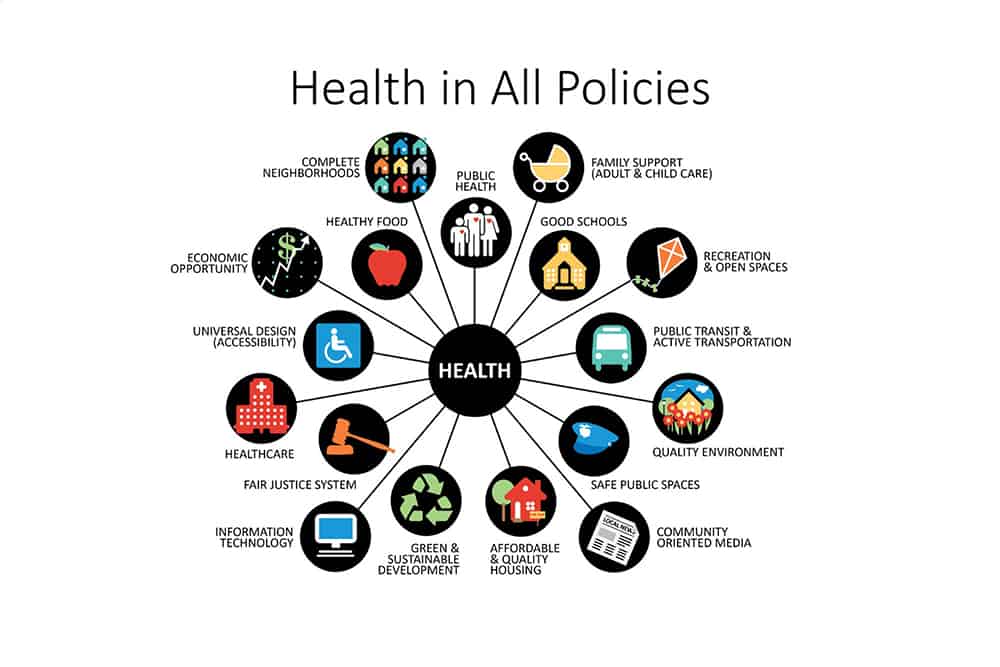COVID-19 Spotlights Connections Between Health and Other Sectors
COVID-19 has thrown many things we in public health have long been working on into stark relief for a broader audience: the importance of sufficient public health funding; the role of our physical and social surroundings in determining our health; how policies, systems and environments contribute to health inequities; and (perhaps the most visceral realization) how interconnected we all are – as individuals, communities, organizations and sectors – when it comes to health and well-being.
We have seen millions of individuals come together by staying apart, keeping physically distant in order to protect everyone in their broader communities, recognizing that we all depend on one another to minimize spread of this novel coronavirus.
We have seen neighboring communities and states in the U.S. come together to take coordinated action on stay at home orders, reopening plans and other legal and policy matters, recognizing that cooperation and collaboration are essential to tackling a disease that knows no borders.
We have seen organizations around the world come together to share data and knowledge to accelerate the development of diagnostics, vaccines and therapeutics, recognizing that reducing inefficiencies and duplication of effort is key to bringing the spread of COVID-19 under control as quickly as possible.
Without a doubt, our health as individuals and communities is deeply intertwined. Just as important to acknowledge is that health itself is intertwined with affordable and quality housing, good schools, safe neighborhoods, sufficient family support such as child care, economic opportunity and the list goes on, and on and on.
The current pandemic exposes and illuminates these connections in striking fashion.
- With millions of children out of school and childcare, parents and caregivers are juggling essential or remote work, or the stress of unemployment, with caring for children. The experience underscores the lack of family supportive policies in the U.S., ranging from paid sick and family leave to safe and affordable childcare options to adequate pay and support for childcare workers.
- The closing of schools and childcare facilities across the nation also puts the nearly 35 million children served daily by the National School Lunch and Breakfast Programs and Child and Adult Care Food Program at risk of losing vital nutrition and financial assistance. Families facing higher food-related costs may in turn be forced to forgo other needs like healthcare services or utilities.
- Being confined to one’s home is particularly dangerous for victims of domestic violence, a situation that can be exacerbated by the stress of losing a job or having children out of school. Across the U.S., there has been a rise in reports of domestic violence incidents.
- For those experiencing homelessness in the U.S., COVID-19 safety measures such as staying at home – or even washing hands – can be impossible to meet. As businesses close, jobs are lost and social services stretched thin, even more individuals turn to homeless shelters, where crowding and difficulty maintaining sanitary and safety standards can put these individuals at even greater risk of contracting the virus.
- The nation’s criminal legal and immigrant detention systems also put individuals at high risk for contracting the virus due to overcrowding, unsanitary conditions, a population that is more vulnerable to COVID-19 as a result of pre-existing conditions and the large number of people that cycle in and out of these facilities.
Notably, the kinds of consequences outlined above will disproportionately impact those already pushed to the brink by low wages; by neighborhood forces like red-lining, gentrification and food deserts; and by systemic institutional racism and discrimination.
Of course, these connections between health and other sectors – and their unequal impact on certain populations – are in no way unique to COVID-19, and public health professionals have long been sounding the call that upstream social determinants play a huge role in all aspects of our health and well-being.
It is long past time to heed that call and make significant and sustained investments in addressing these upstream determinants (the recently introduced Improving Social Determinants of Health Act of 2020 would be a promising start). Not only does our ability to find our way out of this crisis depend on such investment, so does our ability to meaningfully improve health and well-being for all.
Notably, addressing these upstream determinants of health in effective and sustainable ways is impossible without multi-sector collaboration. (More on that in Part 2)
Vinu Ilakkuvan is passionate about supporting and strengthening multi-sector community efforts to address the upstream, root drivers of health. Through her consulting practice, PoP Health, LLC, Vinu provides a range of consulting services (including in the areas of community collaboration, research, and communication) in this space. Vinu holds a DrPH in Health Behavior and a MS in Health Communications, and teaches and advises thesis students at George Washington University’s Milken Institute School of Public Health.
Graphic by DHHS.



